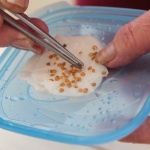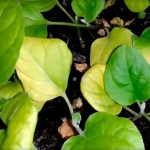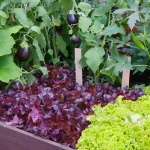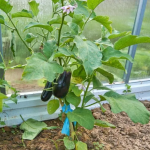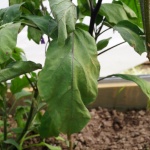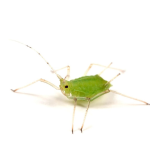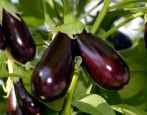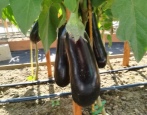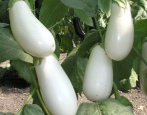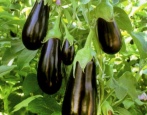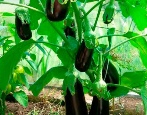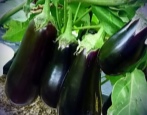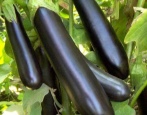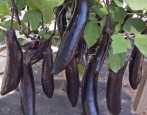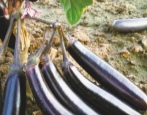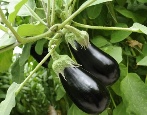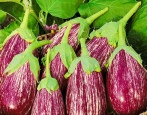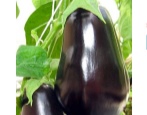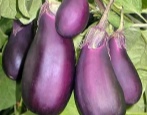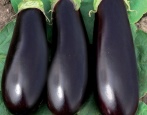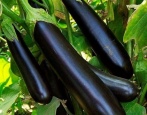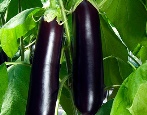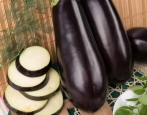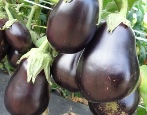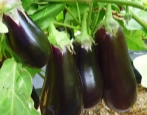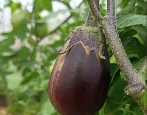
- Authors: Gavrish S.F., Kapustina R.N., Verba V.M.
- Year of approval: 2017
- Growth type: medium-sized
- Bush height, cm: 70–130, in greenhouses the height can reach up to 150
- Fruit shape: cylindrical, strongly curved (sometimes serpentine-curved)
- Fruit weight, g: 150-230
- Fruit color: purple with lilac tint
- Ripening terms: mid-early
- Pulp (consistency): dense
- Color of the pulp: white with a greenish tint
The Black Prince is one of the best non-hybrid varietal eggplants. Vegetable growers appreciated it for its attractive appearance, very tasty fruits, amicable ripening and unpretentious care.
Breeding history
The variety was included in the State Register in 2017. Eggplant owes its appearance to domestic breeders Gavrish S.F., Kapustina R.N., Verbe V.M.When creating this vegetable, the emphasis was placed on high productivity and strong immunity.
Description of the variety
The culture is universal. Among the advantages are the following:
long-term and continuous fruiting;
persistent immunity to major infections and pests;
small bushes do not take up much space on the site;
ease of care;
excellent taste characteristics;
high rates of transportability and keeping quality after harvest.
There are also disadvantages.
High demands on lighting. The plant even does not tolerate a small partial shade, which is why the growth of the vegetable stops.
Do not plant eggplants next to tomatoes, potatoes and garlic. Comfortable neighbors for him can be onions, cabbage and cucumber.
The black prince is sensitive to sudden changes in temperature.
Whimsical to the composition of the soil and the quality of irrigation.
Characteristics of the appearance of plants and fruits
The plant is medium-sized. On average, the height of the bush can reach 70-130 cm, in a greenhouse, the height can reach 150 cm. The crown is semi-spreading. The stem is green, slightly pubescent, without anthocyanin color. Leaves of medium size are slightly wrinkled, with strongly wavy edges, saturated light green color. Thorns are almost completely absent or very rare.
In shape, the fruits resemble a strongly curved cylinder, sometimes serpentine-curved. On average, the length can reach 24-26 cm, in diameter 2-3 cm. The average weight of one fruit is 150-230 grams. The color of ripe fruits is rich purple with a lilac hue. The skin is not thick, with a firm gloss.
Purpose and taste
The black prince has a classic eggplant taste, but without bitterness. Dense white flesh with a greenish tinge. The shape of the fruit is practical, allowing you to cut into circles or long strips of the same size. The vegetable makes delicious snacks, eggplant caviar, first and second courses. It is also convenient to preserve small cylinders.
Ripening terms
Medium early grade. From the moment of germination to the beginning of harvest, 105-110 days pass. Fruiting is long, until the onset of the first frost, provided that the plant is covered with agrofibre at night.
Yield
The Black Prince is a high-yielding crop. When grown under a film, on average, the plant gives 8.7-8.8 kg of vegetables.
Growing regions
The variety can be cultivated virtually throughout the country. However, the plant is more recommended for growing in the south in the open field or for a film shelter in regions with a temperate climate.
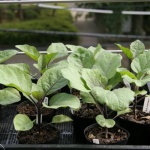
To get a tasty and bountiful eggplant crop, you must first grow strong and healthy seedlings. This culture is considered very capricious, therefore, you need to take care of seedlings when growing at home as correctly and carefully as possible.
Landing scheme
The planting scheme is 40x60 cm. Despite the fact that the bushes are compact, there is no need to thicken the beds. Each plant should have enough light, moisture and warmth.
Growing and care
The seedling method of growing eggplants makes it possible to get an early harvest. Seeds begin to germinate at the end of February. The seedlings are ready for transfer to a permanent place when they reach the age of 65-70 days. Planting in open ground or a greenhouse is carried out at the end of May. But in general, the timing depends on the climatic conditions of the region.
Eggplant is picky about the composition of the soil. Therefore, the soil is prepared a few days before sowing the seeds. Experienced gardeners are advised to purchase a ready-made one. It does not have to be additionally disinfected, and it contains the necessary elements for good development.
Eggplants do not tolerate transplanting well, therefore, for less trauma, it is better to immediately sow them in separate cups. The seed is first prepared. Soak for 30 minutes in a weak solution of potassium permanganate, then rinse well, and leave in a damp cloth for several days so that the seeds germinate. As soon as they begin to hatch, they are carefully deepened 1 cm into the soil mixture and sprinkled.
Next, the containers are covered with foil and placed in a bright place for germination. It should be noted that the variety germinates at high temperatures of + 25 ... 28 degrees. After the emergence of seedlings, they begin to harden, lowering the temperature to + 15 ... 20 degrees. Water the plant only with warm, settled water under the root.
The moisture content of the soil must be monitored constantly, avoiding drying out and excessive waterlogging. Top dressing (nitrogen, phosphorus, potassium) is applied regularly and simultaneously with irrigation. Weeding and loosening of the earth are systematically carried out.
The black prince needs to be shaped. To do this, remove all lateral shoots and leaves until the first fork, by the end of July, 5-6 of the largest ovaries are left on the plant, other flowers and ovaries are removed.
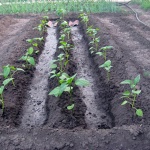
Planting eggplant is one of the most important stages in growing. When choosing a place for eggplants on your site, it is important to remember that this culture should be in warm soil, constantly illuminated by the sun. The plant is also very fond of spacious, open spaces, since its roots can grow over sufficient areas.
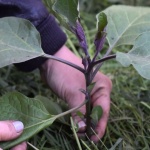
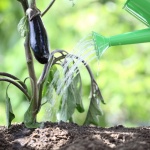
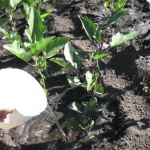

Eggplant is one of the most demanding crops. For its successful cultivation, it is necessary to create optimal conditions, as well as to carry out prevention and fight against diseases and pests. Eggplant often infects both fungal and viral diseases. If treatment is not started on time, you can completely lose the crop.
